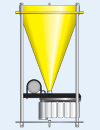
 Today's Weather
Today's Weather
Sunny
Latitude: 28.34 N
Longitude: -89.35 W
Air temperature: 51.6 F (10.9C)
Water temperature: 74.5F (23.6C)
Barometric pressure: 1023.1mb
Visibility: unlimited
Seas: 1-2 feet
Wind: NNE, 11mph

Related link:
Tracking the Oil Spill
in the Gulf
New York Times interactive
One of Those Days
December 07, 2010 (posted December 8, 2010)
by Ken Kostel
After two days of a cold north breeze, we awoke today to warmer weather and a lot less wind. Certainly, it was a sign of good things to come. But not everything can go your way on a research cruise. There are just too many variables. Too much that can go wrong.
And this is the ocean. The deep ocean. It’s an unforgiving place to do anything, much less advanced scientific research and precision engineering. Today proved that.
First thing after breakfast, we stopped at a spot about 70 miles southwest of the Deepwater Horizon oil rig that exploded and sank in April. Steve Murphy sent a coded acoustic signal into the water and 10 minutes later a bright yellow float bobbed to the surface. After a little heavy wrangling by the Atlantis crew, the sediment trap mentioned in yesterday’s post was safely on deck.
A quick look at the instrument, and we knew something was amiss. Water was leaking out of the pressure housing that protects the control unit, and none of the collection bottles had rotated into sampling position. The instrument had failed, probably soon after deployment. It had not taken a single sample. As happens everywhere, things break. But the probability of that increases exponentially in the deep sea.
There isn’t much you can do except chalk it up to experience and move on; and move on we did—to a spot six miles southwest of Deepwater Horizon. Chuck Fisher and some others on this cruise discovered a patch of dead and dying coral there a few weeks ago that were covered in a thick brown substance. This is to be our site for an Alvin dive tomorrow and the cruise plan called for the autonomous underwater vehicle (AUV) Sentry to make an overnight dive to map the seafloor and take photographs in an area not yet visited.
Sentry went into the water just after a brilliant sunset and, like an eager bloodhound, plunged out of sight almost immediately. I stopped by the Sentry team’s computer lab just before dinner and everything seemed fine. The vehicle was spiraling down to its launch point 40 meters above the bottom where it would begin surveying the seafloor. Then it would descend to 5 meters above the seafloor and take photographs of known coral communities.
James Kinsey, assistant scientist in the Sentry Group, pointed to the first 90-degree turn on the survey track and said, “That’s where we’ll get nervous. If we can get past the first turn, we’ll feel a lot better.” Even so, everyone was feeling confident in the yellow robot.
Unfortunately, Sentry wouldn’t even get to that critical point. As it neared the bottom, for some reason, it immediately aborted the mission. We recovered Sentry in the dark just an hour after we set it loose.
Anyone will tell you things go wrong all the time in research. It might be a cliché, but you really do have to learn from your mistakes and learn to move on. Even the balky sediment trap might, according to WHOI biologist Tim Shank, provide a helpful “control” against which he and others will be able to analyze future samples. It’s also an important lesson for the folks who build the pressure housings that they will use to refine their designs.
And Sentry? Within an hour of having it back on deck, the Sentry crew identified the problem—a faulty sensor that measures humidity inside the vehicle to monitor for leaks. They fixed it and at 9:50 p.m., Sentry went back in the water for a second try.
It’s been one of those days, and it’s not over yet.
Tomorrow, Alvin makes its first dive. For now, we wait to hear from Sentry.
Read the new Hot Topic

Instruments: The Sediment Trap
Sediment traps gather microscopic particles falling through the ocean—some of which become food for animals on the bottom. Learn more »
[ Previous update ] [ Next update ]
[Back
to top] |